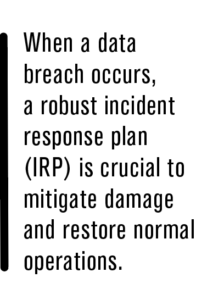October is Cybersecurity Awareness Month, an ideal time for real estate professionals to focus on safeguarding their digital assets and client information. In today’s day and age, real estate professionals handle sensitive client data, making them prime targets for cyberattacks. When a data breach occurs, a robust incident response plan (IRP) is crucial to mitigate damage and restore normal operations. Here are the top tips for creating an effective IRP tailored to your business.
1. Assemble a response team
An effective IRP starts with a dedicated response team. This team should include:
- Incident response coordinator: Oversees the response efforts.
- IT professionals: Handles technical aspects, such as identifying and containing the breach.
- Legal advisors: Ensures compliance with data protection laws and advises on legal obligations.
- Communications specialist: Manages internal and external communications.
- Management: Makes critical decisions and allocates resources.
 2. Identify critical data and systems
2. Identify critical data and systems
Determine which data and systems are critical to your operations. This includes client information, transaction details and communication systems. Understanding what’s most valuable will help prioritize response efforts and protect the most sensitive information.
3. Develop clear communication protocols
Effective communication is essential during a breach. Establish protocols for:
- Internal communications: Ensure team members are informed and coordinated.
- External communications: Prepare templates to notify clients, partners and stakeholders. Be transparent about the breach and the steps being taken.
- Regulatory notifications: Identify and comply with regulatory requirements for reporting data breaches.
4. Create detailed response procedures
Outline step-by-step procedures for addressing different types of incidents:
- Detection and analysis: Define how to identify and analyze a breach.
- Containment: Immediate steps to contain the breach and prevent further data loss.
- Eradication: Remove the cause of the breach from your systems.
- Recovery: Restore affected systems and verify their integrity.
- Post-incident review: Analyze the breach and response to identify lessons learned and improve future responses.
5. Regularly update and test the plan
Cyber threats evolve, and so should your IRP. Regularly review and update your plan to address new vulnerabilities and threats. Conduct periodic drills and simulations to test the effectiveness of your response procedures. This helps ensure your team can respond swiftly and effectively should a real incident strike.
6. Implement strong security measures
Prevention is the best defense against data breaches. Implement robust security measures such as:
- Firewalls and antivirus software: Protect your network and devices from malicious attacks.
- Encryption: Ensure sensitive data is encrypted.
- Access controls: Restrict access to sensitive information based on roles and responsibilities.
- Regular updates: Keep all software and systems up to date with the latest security patches.
7. Educate and train your team
Ensure that all team members understand their roles in the event of a breach. Provide regular training on cybersecurity best practices, including how to recognize phishing attempts and secure sensitive data. An informed team is better equipped to prevent and respond to sudden attacks.
8. Engage with cybersecurity experts
Consider partnering with cybersecurity experts who can provide additional support and guidance. They can help you develop and refine your IRP, conduct vulnerability assessments and respond to incidents more effectively.
9. Maintain documentation
Keep detailed records of all incidents and responses. Documentation should include the nature of the breach, steps taken to contain and mitigate it, communications and any lessons learned. This information is valuable for improving your response plan and meeting regulatory requirements.
10. Review legal and regulatory requirements
Familiarize yourself with legal and regulatory requirements related to data breaches in your jurisdiction. Ensure your IRP complies with these requirements to avoid legal penalties and maintain trust with clients and partners.
Visit RRC’s Education Catalog for on-demand cybersecurity content at www.CRS.com/education/education-catalog.
Photo: fonikum Digital Vision Vectors via Getty Images








